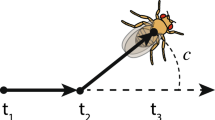Abstract
The effect of temperature and sex on spatial distribution ofDrosophila melanogaster adults was studied in a specially designed apparatus. It was observed that individuals tend to aggregate in sections of the sphere independently of sex and temperature. Nevertheless, decrease in temperature increase aggregation. The mobility of both males and females indicates a megative geotactic tendency.
Similar content being viewed by others
References
Alle, W. C. (1951).Cooperation Among Animals, Schumann, New York.
Ayala, F. J. (1966). Dynamics of populations. I. Factors controlling population growth and population size inDrosophila serrata.Am. Naturalist 100:213–219.
Ayala, F. J. (1967). Evolution of fitness. I. Improvement in the productivity and size of irradiated populations ofDrosophila serrata andD. birchii.Genetics 53:883–895.
Ayala, F. J. (1970). Competition, coexistence, and evolution. In Hecht, M. K., and Steere, W. E. (eds.),Essays in Evolution and Genetics in Honor of Th. Dobzhansky, Appleton-Century-Crofts, New York, pp. 121–158.
Brncic, D., Koref-Santibañez, S., Budnik, M., and Lamborot, M. (1969). Rate of development and inversion polymorphism inDrosophila pavani.Genetics 61:471–478.
Budnik, M., Bracic, D., and Koref-Santibañez, S. (1971). The effects of crowding on chromosomal polymorphism ofDrosophila pavani.Evolution 25:410–419.
Cole, C. L. (1964). A study of the cryptozoa of an Illinois woodland.Ecol. Monogr. 16:65–103.
del Solar, E. (1968). Selection for and against gregariousness in the choice of oviposition sites byDrosophila pseudoobscura.Genetics 58:275–282.
del Solar, E., and Palomino, H. (1966a). Choice of oviposition inDrosophila melanogaster.Am. Naturalist 100:127–134.
del Solar, E., and Palomino, H. (1966b). Tendencia gregaria enDrosophila melanogaster.Biologica 39:27–31.
Kearsey, M. J. (1965). Cooperation among larvae of a wild type strain ofDrosophila melanogaster.Heredity 20:309–312.
Lewontin, R. C., and Matsuo, T. (1963). Interaction of genotypes determining the viability inDrosophila busckii.Proc. Natl. Acad. Sci. 49:270–278.
Marise, T. (1966). The mode of migration ofDrosophila ananassae under competitive conditions.Jap. J. Genet. 37:451–461.
Ohba, S. (1961). Analytical studies on the experimental populations ofDrosophila. I. The effect of larval population density upon the preadult growth inD. melanogaster andD. virilis.Biol. J. Okayama Univ. 7:87–125.
Palomino, H., and del Solar, E. (1971). Elección del sitio de oviposición enDrosophila: Coexistencia deD. melanogaster yD. funebris.Genet. Iberica 23:25–33.
Pearl, R. (1932). The influence of density of population upon eggs production inD. melanogaster.J. Exptl. Zool. 63:57–84.
Author information
Authors and Affiliations
Rights and permissions
About this article
Cite this article
Navarro, J., del Solar, E. Pattern of spatial distribution inDrosophila melanogaster . Behav Genet 5, 9–16 (1975). https://doi.org/10.1007/BF01067577
Received:
Accepted:
Issue Date:
DOI: https://doi.org/10.1007/BF01067577



